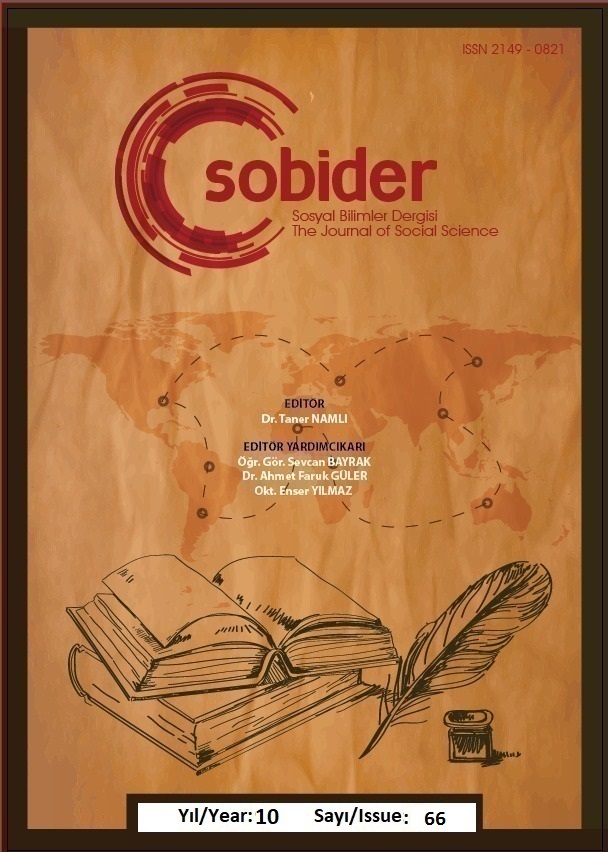Author :
Abstract
Bu makale; sanatçı, sanat eseri, izleyici ve toplumsal zemin arasındaki korelasyona odaklanarak, sanat yapıtlarını semiyotik açıdan anlayıp hermeneutik bir anlayışla, biçimsel analizden sosyo-kültürel yorumlamaya kadar uzanan çeşitli içerik ve yaklaşımlarla değerlendirip, anlamlandırmayı amaçlamaktadır. Araştırma kapsamında, sanat eleştirisini tanımlanıp, analitik çözümleme, yorumlama ve yargı yöntemlerini belirli başlıklar çerçevesinde ele almaya çalışılacaktır. Bu yaklaşımla, resmi yorumlama ve yaratma dinamik bir süreç olarak ele alınıp eğitimcilerin ve araştırmacıların sanat ve tasarım eğitimine daha derinlemesine bağlantılar kurmasına, teori ile pratik arasındaki ilişkiyi geliştirmesine ve geleneksel öğrenme ortamlarının sınırlarını genişletmesine yardımcı olabilecek örneklem oluşturmaya çalışılacaktır. Teorik tartışma bağlamında “resim” kültürel pratiklerini etiketlemek yerine, resmi hermeneutik olarak işleyebileceği konusundaki pratiklik ve somut öğrenme durumlarına atıfta bulunarak bazı yolları belirlemeye yönelik bir çaba olarak tasarlanmıştır. Resmin yorumlanması için öne çıkan yaklaşımlar ve süreçler semiyolojik ve hermeneutik çerçeve içinde öğrenciler için sanata ilgi duyan izleyiciler için de sorgulama deneyimi sunar. Resmi geleneksel eğitim bağlamının ötesine taşıyan bir uygulamayla ilgili bir perspektif sunarken bir sanat yapıtı karşısında farklı sujelerle dinamik bir etkileşim içerebileceği fikrini kapsar. Ayrıca eserin süje ile arasındaki etkileşim, sadece eğitim içinde resmin dönüştürücü potansiyelini açığa çıkarmakla kalmaz, aynı zamanda yaratıcı uygulamaların daha geniş kültürel ve kişisel bağlamlarla nasıl kesişebileceği şeklinde keşfetmeyi destekler. Burada kullanılan hermeneutik perspektif, eğitimcileri ve araştırmacıları, sanatsal süreçlerde eserlerden ortaya çıkabilecek anlam katmanlarını ve yorumları dikkate almak konusunda yönlendirir.
Keywords
Abstract
This article; By focusing on the correlation between the artist, the artwork, the audience and the social ground, it aims to understand the works of art from a semiotic point of view and to evaluate and make sense of them with a hermeneutic approach, with various contents and approaches ranging from formal analysis to socio-cultural interpretation. Within the scope of the research, art criticism will be defined and analytical analysis, interpretation and judgment methods will be tried to be discussed within the framework of certain titles. With this approach, formal interpretation and creation will be handled as a dynamic process, and it will be tried to create a sample that can help educators and researchers establish deeper connections to art and design education, develop the relationship between theory and practice, and expand the boundaries of traditional learning environments. Rather than labeling cultural practices of "painting" in the context of theoretical discussion, it is designed as an effort to identify some ways in which painting can function hermeneutically, by referring to practical and concrete learning situations. Prominent approaches and processes for the interpretation of the painting, within a semiological and hermeneutic framework, provide an experience of inquiry for the students and the audience who are interested in art. While presenting a perspective on a practice that takes painting beyond the traditional educational context, it includes the idea that a work of art can involve a dynamic interaction with different subjects. In addition, the interaction of the work with the subject not only reveals the transformative potential of painting in education, but also supports the exploration of how creative practices can intersect with broader cultural and personal contexts. The hermeneutic perspective used here guides educators and researchers to consider the layers of meaning and interpretations that may arise from works in artistic processes.





